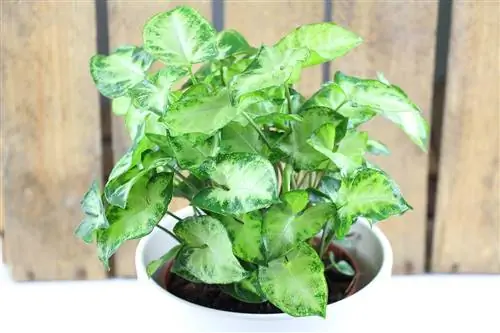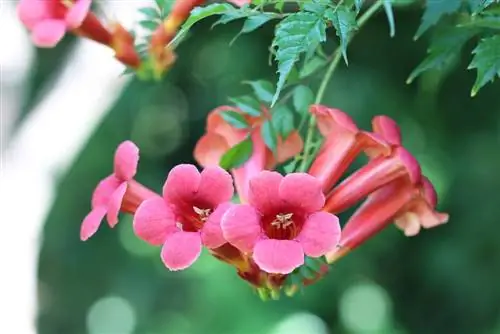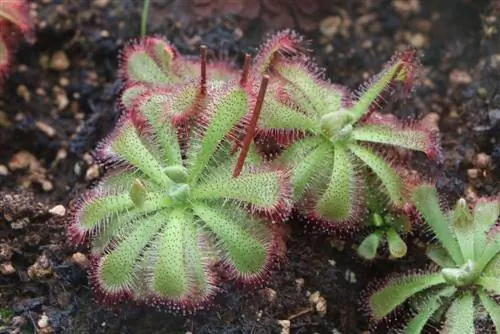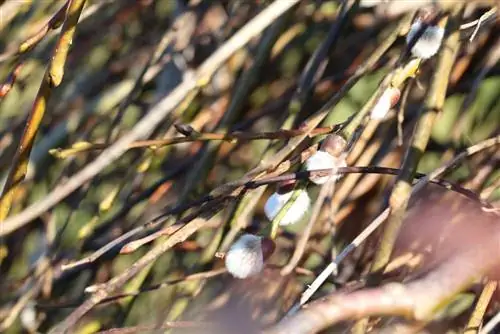- Author admin [email protected].
- Public 2023-12-17 03:39.
- Last modified 2025-01-24 12:45.
A beautiful flower emerges from the center of the funnel-shaped leaves. These are actually exceptional bracts. The actual flower is rather inconspicuous and significantly smaller. These bracts can be colored in shades of orange, red, pink and yellow and have various shapes. The plant from the tropical rainforest proves to be very easy to care for if the gardener follows a few simple rules. Find out here what you can do to ensure your bromeliad thrives.
Short profile
- Botanical name: Bromelia
- belongs to the pineapple family
- forms a funnel of dark green leaves
- evergreen, perennial plant
- terrestrial and epiphytic forms available
- die after flowering
Occurrences
Bromeliads belong to the pineapple family, the best-known species of which is probably the pineapple. The approximately 3,000 different species are native to tropical rainforests and grow primarily on trees. For proper care, it is important to know whether it is a form of Bromelia that grows on the ground (terrestrial) or lives on trees (epiphytic). While the first variant can absorb nutrients and water through roots and leaves, with epiphytes this is only possible through the leaves.
Location
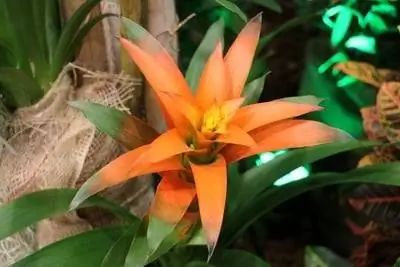
The best location for a bromeliad is a sunny to partially shaded spot on the windowsill, a winter garden or greenhouse. Similar to orchids, bromeliads grow naturally as epiphytes on trees and rarely root in the ground. In the summer, bromeliads are also welcome to go outdoors. If the temperatures are warm enough, they prefer to stand in a partially shaded place under large trees that protect them from the midday sun.
- Light requirements: bright, without direct sunlight
- good on a west or east window
- On the south window only behind a curtain or with shading
- high humidity
- Temperature: warm, always above 14 degrees (especially important outdoors at night)
Depending on the type of bromeliad, the plant has slightly different lighting requirements. All species with hard, leathery leaves require a particularly large amount of light. They are welcome to be exposed to direct morning or evening sun, because then the leaves develop a strong green and he althy color and the bromeliad is able to produce flowers. All species with soft and rather thin leaves must be protected from direct sunlight.
Pouring
The bromeliad loves high humidity, as is the case in its native tropical and subtropical rainforests. But even beyond this extremely high level of humidity, a Bromeliad thrives in the apartment if it is occasionally sprayed with lukewarm water. The best way to do this is with low-lime water from the rain barrel, which should also be used to water the bizarre plant. Watering bromeliads is a bit unusual: you have to pour the water into the funnel-shaped opening in the middle of the leaves. In nature, this funnel is always filled with rainwater and thus forms a natural water reservoir for the epiphyte. With houseplants, the gardener has to help and regularly fill the natural cistern with water. This is usually sufficient as irrigation water, as the bromeliad does not form a strong root system with which it can absorb large amounts of water.
Tip:
Nevertheless, the substrate must not dry out too much and must be watered regularly. This is particularly important for bromeliad species that grow on the ground.
Substrate
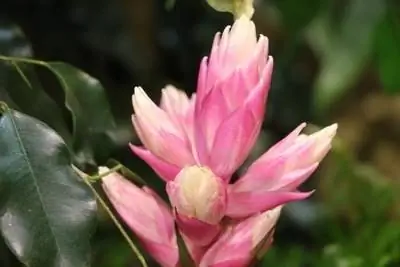
The right substrate depends on the type of bromeliad. Bromeliads that grow on the ground (terrestrial forms) prefer different substrates than epiphytic species that grow on trees.
1. Substrate for terrestrial bromeliad species
- lime-free
- easy
- Mixture of leaf mold and peat moss
- mineral soil mixed with compost
2. Substrate for epiphytic bromeliad species
- good air permeability
- coarse grain
- Mixture of bark and peat moss
- Orchid soil mixed with a little crumbly potting soil
Fertilize
Fertilizing is not absolutely necessary for Bromelia. It grows and thrives just as well without additional nutrients as without, as long as it is planted in good substrate. If you want to do something good for your bromeliad, mix a liquid fertilizer with water during the warm months and add a small amount to the potting soil. For epiphytic plants, the fertilizer can also be applied in very low concentrations via spray water.
Repotting
The pot for a bromeliad doesn't have to be particularly large, but it should provide stability, as bromeliads sometimes grow a little crooked and the plant otherwise risks falling over. The ball of soil around the roots can be kept small. That's why you rarely have to repot a Bromeliad. If it still needs a slightly larger pot, for example because it is growing very crookedly or if its roots have become too wet, it can be planted in a substrate as described above, depending on the species.
Propagation
There are different ways to propagate bromeliads. Some species spread via seeds, others via so-called children.
Kindel
When the bromeliad has almost faded, the beginnings of the offshoots will slowly form. They grow until the mother plant has completely faded. The mother bromeliad then dies and the daughter plants can be carefully separated. The children need some time to grow, so a little patience is required. The children should remain on the mother plant for as long as possible. If they are still too small, they do not have the strength to survive on their own.
- Let children grow until the mother plant dies
- Water cuttings over the cup for about two weeks
- Separate the children when they are about 10 to 15 cm tall
- or the mother plant dies completely
- Removing bromeliads from the pot
- shake off dry soil
- Divide the roots of the mother plant among the daughter plants
- for two offshoots, halve the root mass, etc.
- plant in your own pot
- Cut off and dispose of dead mother plant
- Temperature: at least 20 degrees
- high humidity
- Location: bright, without direct sunlight
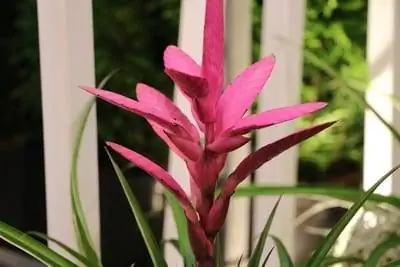
Since bromeliads absorb a lot of water and nutrients through their leaves, they should be sprayed frequently with water at the beginning. The children take a relatively long time to grow. It usually takes about two months for the leaves to open. In the meantime, the substrate must not be too moist, otherwise the young plants will rot. It takes about a year for home-grown bromeliads to bloom. Then the cycle begins again.
Seeds
Some species do not form offshoots after flowering, but only produce seeds. In this case, the ripe seeds must be sown. This works best in spring in a plant bowl or a mini greenhouse that is placed on the warm windowsill.
- Time: Spring
- Sprinkle seeds only on the substrate
- press lightly
- do not cover with soil (light germinator)
- Substrate: peat moss or peat mixed with sand
- spray with soft water
- cover with bag or glass
- ventilate occasionally
- set up warm and bright
- without direct sunlight
- Germination temperature: 23 to 27 degrees
- Germination time: about 14 days
When the first real leaves are visible, the plastic bag can be slowly opened and finally removed completely.
Ripe apples accelerate growth
You have to wait quite a long time for some bromeliads to bloom. But there is a trick to speed up flower formation. To do this, place a few ripe apples together with the bromeliads in a plastic bag overnight. After about six weeks the flowers appear (on mature plants). Ripe apples release ethylene and thus promote not only the formation of flowers, but also the growth of the children on the mother plant.
Tillandsia
In addition to the well-known funnel bromeliads, tillandsias also belong to the bromeliad family. They form a very special genus within the pineapple family. Tillandsias are also popularly known as air carnations because they give the impression that they only live on air and love. But like most bromeliads, Tillandsias also grow epiphytically on other plants or rocks. Their roots only serve to give the plants support. Therefore they must under no circumstances be planted in substrate. This would cause the tillandsia to rot in no time. It is better to place them on a root or a stone. To do this, wrap the roots with a little moss and tie them to the base with a plastic-covered wire. Since Tillandsias do not have a water reservoir, they absolutely need high humidity. Where this is not possible, you can also spray them with low-lime water.
Wintering
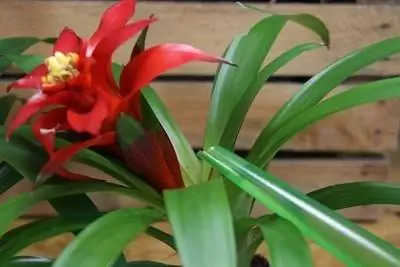
If the temperatures fall below 15 degrees at night again, the bromeliads that have spent the summer outdoors must definitely be brought back into the warm room. Temperatures below 14 degrees cause the heat-loving plant to die. If the bromeliad is directly above the heater, a change of location is only necessary if the plant shows signs of drought damage. At moderate temperatures, it is usually sufficient to spray them regularly with lime-free water. If that is not enough and the leaves are already starting to change color, the bromeliad should be placed in a slightly cooler room (such as the bedroom or alternatively by the window in the bathroom). It's not necessarily cooler in the bathroom, but the humidity is usually quite high.
Diseases and pests
The bromeliad is most likely to become ill when the humidity is too low. Over time, the leaves turn yellow or brown and eventually fall off. Pests such as mealybugs and scale insects occur primarily in the winter months when the plant is weakened by the dry heating air. To minimize the risk, the bromeliad should be sprayed regularly. Bowls of water on the radiator or windowsill also increase the humidity. If the tropical plant is already infected, paraffin or neem oil in the spray water has proven effective for funnel bromeliad species. Natural enemies such as parasitic wasps can also be used.
Conclusion
A very special feature when caring for bromeliads is watering. Bromeliads absorb water through their leaves. For this reason, they have formed a small cistern in the middle in the shape of a leaf funnel in which rainwater collects in the wild. That's why it is also watered as a houseplant with soft water in the leaf funnel. The substrate must not dry out and must also be watered regularly.


